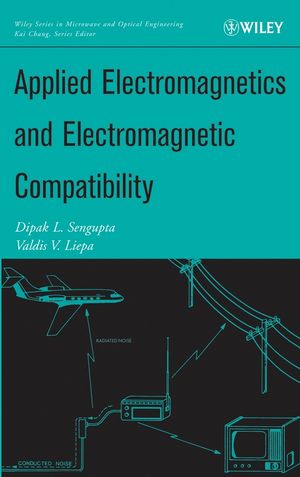Applied Electromagnetics and Electromagnetic CompatibilityISBN: 978-0-471-16549-1
Hardcover
510 pages
November 2005
 This is a Print-on-Demand title. It will be printed specifically to fill your order. Please allow an additional 10-15 days delivery time. The book is not returnable.
|
||||||
Preface.
Acknowledgments.
1 General Considerations.
1.1 Introduction.
1.2 Definitions.
1.3 Interference mechanisms.
1.4 Examples.
1.5 Discussion.
References.
2 The Electromagnetic Environment.
2.1 Introduction.
2.2 Natural Noise.
2.3 Man-Made Noise.
2.4 CW and Transient Sources.
2.5 Characteristic Parameters of Authorized Radiators.
2.6 Noise Emission Intensity.
2.7 Home Environment.
2.8 Discussion of Noise Sources.
2.9 Subject Matter of the Book.
References.
3 Fundamentals of Fields and Waves.
3.1 Introduction.
3.2 Basic Parameters.
3.3 Time Dependent Relations.
3.3.1 Continuity of Current and Conservation of Charge.
3.3.2 Faraday's Law.
3.3.3 Ampere's Circuital Law.
3.3.4 Lorentz Force Law.
3.3.5 Maxwell's Equations.
3.3.6 Historical Commt:nts on Maxwell's Equations.
3.3.7 Media Considerations.
3.3.8 Boundary Conditions.
3.3.9 Energy Flow and Poynting's Theorem.
3.3.10 Uniqueness Theorem.
3.4 Harmonically Oscillating Fields.
3.4.1 Introduction.
3.4.2 Phasors.
3.4.3 Time Harmonic Relations.
3.4.4 Complex Permittivity.
3.4.5 Boundary Conditions Again.
3.4.6 Notes on the Solution.
3.4.7 The Complex Poynting Theorem.
3.5 The Wave Equation.
3.5.1 Time Dependent Case.
3.5.2 Time Hannonic Case.
3.6 Uniform Plane Waves.
3.6.1 General Considerations.
3.6.2 Energy Considerations.
3.6.3 Group Velocity.
3.6.4 Summary.
3.6.5 General Representation of TEM Waves.
3.6.6 Plane Waves in Lossy Media.
3.6.7 Skin Effect.
3.6.8 Polarization of Plane Waves.
3.7 Reflection and Refraction (Transmission) of Plane Waves.
3.7.1 Normal Incidence on a Plane Interface.
3.7.2 Oblique Incidence.
References.
Problems.
4 Signal Waveform and Spectral Analysis.
4.1 Introduction.
4.2 Classification of Signals.
4.3 Energy Signals.
4.3.1 Definitions.
4.3.2 A Rectangular Pulse.
4.4 Power Signals.
4.4.1 Periodic Signals.
4.4.2 Trapezoidal Waveform.
4.5 Examples of Some Signals.
References.
Problems.
5 Transmission Lines.
5.1 Introduction.
5.2 Basic Discussion.
5.3 Transverse Electromagnetic (TEM) Transmission Lines.
5.4 Telegrapher's Equations: Quasi-Lumped Circuit Model.
5.5 Wave Equations.
5.6 Frequency Domain Analysis.
5.6.1 General Solution.
5.6.2 Further Discussion of Propagation Constant and Characteristic Impedance.
5.6.3 Voltage, Current, and Impedance Relations.
5.7 Line Parameters.
5.7.1 Coaxial Line.
5.7.2 Parallel Wire Line.
5.7.3 Parallel Plate Line.
5.7.4 Circular Wire above a Ground Plane..
5.7.5 Microstrip Line.
5.7.6 Stripline.
5.7.7 Comments.
5.8 Transients on Transmission Lines.
5.8.1 Initial and Final (Steady State) Values.
5.8.2 Transient Values.
5.9 Measurements.
5.9.1 Slotted Line Measurements.
5.9.2 Network Analyzer Measurement.
References.
Problems.
6 Antennas and Radiation.
6.1 Introduction.
6.2 Potential Functions.
6.3 Radiation from a Short Current Element.
6.3.1 Complete Fields.
6.3.2 Near Zone and Far Zone Considerations.
6.3.3 Near Zone and Far Zone Fields.
6.3.4 Radiated Power and Radiation Pattern.
6.3.5 Wave Impedance.
6.4 Radiation from a Small Loop of Current.
6.4.1 Complete Fields.
6.4.2 Far Zone Fields.
6.4.3 Radiated Power.
6.4.4 Wave Impedance.
6.5 Fundamental Antenna Pal-ameters.
6.5.1 Radiation Intensity.
6.5.2 Directivity and Gain.
6.6 Far Fields of Arbitrary Current Distributions.
6.6.1 The Radiation Vector and the Far Fields.
6.6.2 Vector Effective Length of an Antenna.
6.6.3 Summary.
6.7 Linear Antennas.
6.7.1 Center-Fed Linear Antenna.
6.7.2 Far Fields of a Dipole of Length.
6.7.3 Radiated Power and Directivity.
6.7.4 Cosine, Sine, and Modified Cosine Integrals.
6.7.5 The Half-Wave Dipole.
6.8 Near Field and Far Field Regions.
6.8.1 Basic Assumptions.
6.8.2 Point or Small Sources.
6.8.3 Extended Sources.
6.8.4 Definitions of Various Regions.
6.8.5 Specific Values of the Region Boundaries.
6.9 Equivalent Circuits of Antennas.
6.9.1 Transmitting Antenna.
6.9.2 Receiving Antennas.
6.9.3 Equivalent Area.
6.10 Antenna Arrays.
6.10.1 General Considerations.
6.10.2 A Two-Element Array.
6.1 1 Antennas Above Ground.
6.1 1.1 Ground and Ground Plane.
6.1 1.2 Image Theory.
6.11.3 Images of Electric Current Elements above Perfect Ground.
6.1 1.4 Dipoles above Ground.
6.1 1.5 Monopole Antennas.
6.12 Biconical Antenna.
6.12.1 Biconical Transmission Line.
6.12.2 Finite Biconical Antenna.
References.
Problems.
7 Behavior of Circuit Components.
7.1 Introduction.
7.2 The Series RLC Circuit.
7.3 Definitions of Lumped Circuit Paranleters R, L, and C.
7.3.1 Circuit Theory Description.
7.3.2 Field Theory Description.
7.4 Round Wires.
7.4.1 Resistance.
7.4.2 Internal Inductance.
7.5 External Inductance of Round Wire Configurations.
7.5.1 General Relations.
7.5.2 Circular Loops.
7.6 Inductance of Straight Wires.
7.6.1 Partial Inductance.
7.6.2 Inductance of a Closed Rectangular Loop.
7.7 Other Configurations.
7.7.1 Printed Circuit Board (PCB) Lines.
7.7.2 Microstrip, Strip, and Coplanar Lines.
7.8 Behavior of Circuit Elements.
7.8.1 Bode Plots.
7.8.2 Resistors.
7.8.3 Capacitors.
7.8.4 Inductors.
References.
Problems.
8 Radiated Emissions and Susceptibility.
8.1 Introduction.
8.2 Main Requirements.
8.3 Emissions from Linear Elements.
8.4 Two Parallel Currents.
8.4.1 Introduction.
8.4.2 Two Parallel Currents.
8.5 Transmission Line Models for Susceptibility.
8.5.1 Introduction.
8.5.2 Voltage Induced on the Two-Wire Transmission Line .
References.
9 Electromagnetic Shielding.
9.1 Introduction.
9.2 Definitions.
9.3 Shielding Effectiveness.
9.3.1 Introduction.
9.3.2 SE Expressions for Computation.
9.4 Shielding Effectiveness: Near Field llluniination.
9.4.1 Electric and Magnetic Sources.
9.4.2 SE Expressions: Near Zone Considerations.
9.5 Discussion.
9.5.1 Far Zone Fields.
9.5.2 Near Zone Fields.
References.
10 Coupling between Devices.
10.1 Introduction.
10.2 Capacitive (Electric) Coupling.
10.3 Magnetic (Inductive) Coupling.
10.3.1 Some Basic Concepts.
10.3.2 Shielding of the Receptor Conductor
References.
11 Electrostatic Discharge (ESD).
1 1.1 Introduction.
11.2 Accumulation of Static Charge on Bodies.
1 1.3 Charging and Charge Separation.
1 1.4 Human Body as Source of ESD.
1 1.5 ESD Waveforms.
1 1.6 Human Body Circuit Model.
1 1.7 ESD Generator and ESD Test.
References.
12 EMC Standards.
12.1 Introduction.
12.2 Current US



